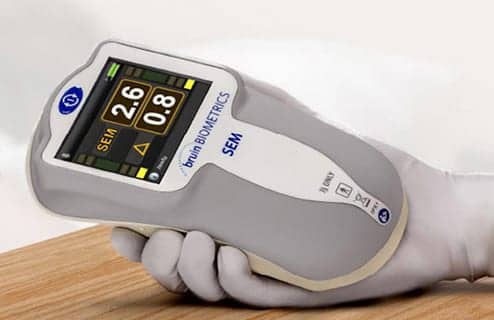Bruin Biometrics LLC has been granted de novo marketing authorization from the US FDA for its SEM Scanner, a wireless handheld device designed to help assess patients who are at increased risk for pressure ulcers.
This authorization was based, in part, on data from a clinical study assessing performance of the SEM Scanner compared to visual skin assessment by nurses in 182 patients at risk for pressure ulcers at 12 hospitals and skilled nursing facilities in the US and the United Kingdom. No adverse or serious adverse events have occurred from SEM Scanner use, notes a media release from Bruin Biometrics LLC.
“Having anatomically specific risk information gives nurses valuable advance notice to institute additional preventive treatment tailored to a patient’s unique needs,” says Dr Ruth Bryant, a SEM Scanner study investigator, author of “Acute & Chronic Wounds” (2016), certified wound ostomy continence nurse, director of nursing research at Abbott Northwestern Hospital in Minneapolis and president-elect of the Association for the Advancement of Wound Care.
“The anatomically specific information combined with tailored preventive actions may ultimately translate into fewer pressure sores, decreased costs, increased quality of patient care, increased patient satisfaction, and decreased risk for adverse events due to pressure ulcers such as in-hospital mortality, prolonged length of stay, discharge to an extended care facility rather than to the home, and infection,” Bryant adds, in the release.
Dr Barbara Bates-Jensen, a professor at the UCLA School of Nursing and the David Geffen School of Medicine and a co-inventor of the SEM Scanner, states, “Objective, scientific data from the SEM Scanner can give clinicians confidence to take action and intervene with methods to prevent pressure ulcers.”
The SEM Scanner is now reportedly the world’s first FDA-authorized device to objectively alert clinicians to specific anatomical areas of a patient’s body at increased risk for developing pressure damage. Patient risk assessments are performed with the SEM Scanner before visible damage manifests at the skin surface.
Current clinical decision-making relies on assessing a patient’s overall risk for pressure ulcer development and then completing a subjective skin and tissue assessment. Both methods suffer from not being able to direct clinicians to where the risk is building until damage is visible at the skin’s surface. Once pressure injuries (also known as pressure ulcers, or bed sores) become visible on the skin’s surface, tissue damage has already occurred.
Elevated readings from the SEM Scanner provide objective clinical information that directs clinicians to heels and sacrums at risk of developing pressure ulcers, even before the damage is visible. These data can facilitate earlier, anatomically specific interventions designed to reverse the damaging effects of pressure and shear and prevent the pressure injuries from breaking through the skin, the release explains.
“Our singular objective is to reduce pressure injury incidence by helping clinicians make prevention real,” shares BBI CEO Martin Burns, who welcomes the FDA’s decision, in the release.
“Total prevention of avoidable pressure injuries is mathematically impossible under the current standard of care. Prevention success demands objective, early, anatomically specific data. For the first time, clinicians will have access to anatomically specific risk assessment data that can be gathered from increased risk patients in all care settings.”
“We are optimistic of the impact these data will have on prevention strategies here in the US,” Burns continues. “With this FDA decision, wound prevention has finally caught up with other areas of healthcare that have long benefited from medical technologies.”
[Source(s): Bruin Biometrics LLC, PR Newswire]




